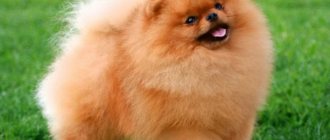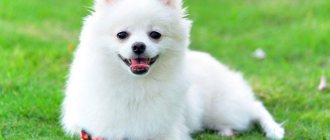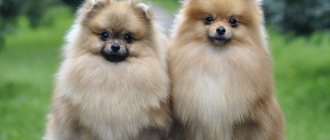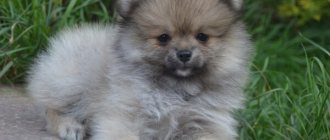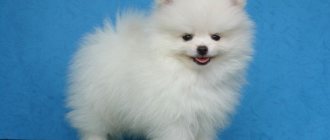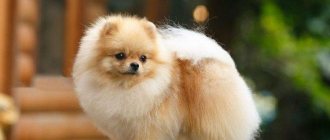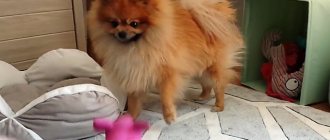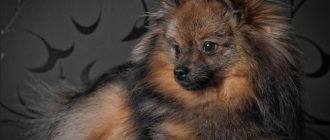Breed characteristics
| Short description | |
| Origin: | Germany |
| Conditions of detention: | Apartment or private house |
| Purpose: | Decorative companion dog |
| Color: | White, black, bicolor, all shades of red from peach to reddish brown, black and tan, blue, marble |
| Wool length: | Long thick guard hair, from 6 centimeters, with dense undercoat |
| Adult dog size: | Height from 18 – 22 cm, weight 2 – 4 kg |
| Average life expectancy: | 15 – 16 years old |
| Walk: | Daily walks are required |
| Physical activity needs: | High physical demands |
| Fédération Cynologique Internationale (FIC) classification: | Group 5. Spitz and primitive breeds, section 4. European Spitz |
| Puppy price: | From 10,000 to 80,000 rubles |
Difficulties in choosing
It is recommended to purchase a puppy at the age of two months. But if the choice fell on a white Spitz, choose dogs after six months. The color of puppies can change up to a year. Fawn babies sometimes turn white. Light red and smoky dogs can also change colors. White puppies often turn cream or gray after molting.
By the color of the fur behind the baby's ears, you can guess what color the Spitz will be. Japanese and American breeds were bred for their white coat; the color of these dogs will not change after molting. You shouldn’t take risks with other types of Spitz; it’s better to let the baby change his coat and leave it with the breeder for up to six months.
The cost of a white puppy does not differ from the price of representatives of other colors. Because after molting, no one can guarantee a snow-white coat without light spots and a uniform light undercoat.
The undercoat may change color after shedding
Spitz nurseries in major cities:
- "Mini Gum" (Moscow);
- "Bon Chanterelle" (St. Petersburg);
- “The Andreev Estate” (Eagle);
- Funny Honey (Kharkov);
- "Solar Joy" (Minsk).
Oh, these are such cool doggies! My friend has 2 puppies like this. Very tiny, just the size of a palm. They run and roll like teddy bears, like little bells. And how smart they are! Dan and Cherry. Everyone responds to their own name. When we walk with them, they do not leave each other. So wonderful. I want to constantly squeeze and caress them. And you can’t tell that these are dogs! Like toys! They get along well with cats. Very playful. And in their eyes you can always see loyalty and devotion!
Valeria, 12/01/2017
History of the origin of the species
The breed got its name “Pomeranian” due to its geographical location. The breed was first spotted in Pomerania, a small Eastern European province in Germany.
Primitive Spitz, a very ancient subspecies, according to some information, the first mentions of similar dogs were several centuries BC. It is not known for certain who exactly gave the main genetic code to the breed; there is an assumption that the Spitz is the ancestor of the ancient Lapland and Spanish sled dogs, the Norrbotten Spitz. Also, huskies and malamutes are distant relatives of the German Spitz.
But the development of the breed, selection work to reduce the size of the dog was carried out mainly in England - it was there that the Spitz was first appreciated. Pomeranians received their modern exterior thanks to Queen Victoria of England, who founded the first nursery. The queen's idea, due to the medieval fashion for small dogs, was to reduce the breed as much as possible.
The average weight of the ancient Spitz was 12 - 14 kg (and they were only white), but Victoria selected the most compact representatives of the species, and only allowed the miniature ones into breeding. Thanks to the painstaking work of the royal nursery, at the end of the 19th century, the Spitz acquired its modern appearance.
The American Kennel Club divides the German (standard) and Pomeranian (dwarf) Spitz into two separate species. The first standard was described by the Americans back in 1870 . The Fédération Cynologique Internationale (FCI) considers the German and Pomeranian to be one breed; a single standard for both subspecies was described only in 1998.
Breeding Miniature Spitz
Bitches of this breed begin to go into heat at about one year of age, but breeding cannot be done right away. Only after the dog reaches 2 years old can you plan to have offspring. Males are bred at 18 months. Bitches come into heat twice a year and last up to 22 days. Before mating, it is imperative to show the animals to a veterinarian.
Dogs are bred after they reach two years of age.
If the bitch is sick, weakened or has signs of obesity, it is better to wait a little while getting offspring. The gestation period for this breed is 63 days. If labor begins on day 57 or earlier, there is a high probability of stillbirth. There can be from 1 to 3 puppies in a litter. During pregnancy, the bitch must be protected from jumping from high heights, hypothermia, blows, etc. In addition, she requires high-quality nutrition.
Due to the small size of Pomeranians, childbirth often occurs with complications. The owner of a bitch needs to be prepared for the fact that the dog will need to be urgently taken to the clinic for a cesarean section. Severe complications occur especially often during the first birth. It is advisable to let the bitch eat the afterbirth, because... this will help normalize her condition and increase her immunity.
The muzzles of newborn puppies should be freed from the amniotic sac. They need to be held upside down so that fluid comes out of the respiratory tract.
Distinctive features
The differences between the standard (German) and dwarf (Pomeranian) Spitz are insignificant, the only difference being their size and health . Pomeranians, due to their compact size and not very skillful breeding work of the Middle Ages, are not distinguished by good health. German prototypes were selected naturally, and like all natives, they have much fewer health problems.
The main distinguishing features of Pomeranians:
- General form. Compact, proportional square dog. Lively, brave and inquisitive.
- Head. Small, wedge-shaped, dry. The ears are small, triangular, erect. The transition from forehead to muzzle is very pronounced. The eyes are dark brown, slightly slanted, medium in size, almost almond-shaped. The cheekbones are slightly prominent.
- Muzzle. The heads are shorter, tapering slightly towards the nose. The nose is black (or matches the shade of fur in chocolate-colored individuals). The lips fit tightly to the jaw, completely covering the lower teeth. Full set – 42 teeth, scissor bite.
- Neck. Moderate length, strong, slightly curved, giving the dog an aristocratic appearance. It widens slightly toward the withers and is covered with longer hair than the body.
- Frame. Compact, but strong for its size. The back is short, with moderately pronounced muscles. The chest is voluminous, dropped almost to the elbows, the stomach is moderately tucked. The loin is short and strong.
- Limbs. The paws are straight, with clearly visible feathering, and the metacarpus are rounded and “cat-like.” The shoulders are strong, with well-developed muscles, directed back. The thighs are strong, the knees are not convex, and the hock joint has a pronounced angle.
- Tail. Throwed over the back, set high, long to the hock joint, with abundant feathering.
Genetics
Spitz coat color has different types of origin and genetic characteristics:
- Albino. This type of color has a main feature: albinos are often deaf from birth. The paired gene in an albino is deafness. The nose and skin of this type of dog will be pink. Eyes - sky blue. The paw pads and mouth will be light. The claws are transparent.
- White color. Dogs of this color carry a gene that prevents the hair from coloring. The nose and mucous membranes of this type may be brown or black. The claws and skin will also be dark. The gene in such individuals is recessive (easily suppressed), which means that in the next generations puppies with all colors can be born. Babies can be born fawn, and after molting they can turn white.
- Lightened colors. Red, chocolate, saddleback, and spotted Spitz dogs may appear white. Lightening of colors occurs under the influence of many genes. In this case, the nose and claws will also be light in color. Most white Spitz dogs are of this type. The owner may be surprised after molting if a snow-white puppy suddenly turns cream or gray by six months.
Snow white fur
An excellent breed for an apartment. This is not a cat that is “on its own.” Spitz is a friend, looking at whom you always want to smile. Very smart, friendly, with a lot of positivity. A whole sea of kindness. Beady eyes, a button nose, a soft, pleasant fluffy coat. In general, I have only positive emotions.
Oksana 03/14/2018
Snow-white color in the breed standard
The rich coat of the Spitz and the variety of colors are reflected in the requirements of the judges who evaluate the appearance of dogs suitable for further breeding work.
Disadvantages of Spitz dogs related to their color:
- the nose is black - round, small, in brown representatives - chocolate (black pigment is not synthesized in the animal's body), in individuals of red and cream color the shade of the nose can be lighter during the molting period and in cold weather;
- lips are not clearly defined, there are no folds in the corners of the mouth; black color of the lips and the presence of pigmentation in the mouth area are mandatory for individuals of all colors, except brown and blue individuals.
In terms of conformation, judges give preference to evenly colored dogs. A dog wearing white socks or a tie can be disqualified.
Most people prefer evenly colored dogs
Disqualifying faults:
- light shade of nose and lips;
- large, bulging or dripping eyes;
- the presence of white spots in light-colored dogs.
Varieties
The rich history and vast geography of the Spitz breed has provided many varieties and species. Some dogs are bred for their personality, others for their color and coat type. All Spitz dogs are white. This color has:
- German Spitz.
- Pomeranian Spitz (Pomeranian).
- Japanese Spitz216.
- Finnish Spitz216.
- American Eskimo Spitz.
- Italian Spitz - Volpino.
- Eurasian Spitz.
- Greenland dog.
Japanese white spitz
All specimens of the American Eskimo are white.
The Spitz unites dogs of different sizes, temperaments and working characteristics. The owner can choose a pet from 18 to 55 cm at the withers. If white color is a priority, then it is worth choosing a breed variety based on size and temperament. The striking white color is beautiful in Pomeranians and large American Eskimo Spitz dogs.
Photo of an adult dog
Spitz behavior
A distinctive behavioral feature of the breed is constant barking. Such a call of nature, of course, is not always associated with aggression, but, as a rule, it is very long-lasting, which can be unpleasant for neighbors. During sleep, you don’t have to worry about noise: Pomeranians are very delicate in this matter, the dog will protect your sleep at all costs.
Another characteristic of Spitz dogs is their intolerance of loneliness. Even a few hours without their owner is difficult for them, not to mention absence for the whole day. These dogs are mobile, so you can take them with you wherever you go. This makes the Pomeranian much more comfortable.
Photos of puppies
Price
The average price for such four-legged animals ranges from ten to thirty thousand rubles. It is better to purchase a furry friend from trusted breeders - this way he will definitely be healthy and, most likely, vaccinated.
But if you need a mixed breed or a dog that does not meet the standards, just for the soul, you can look for one through advertisements on Avito or other free sites. There are plenty of offers. Remember that when choosing, you need to focus not only on appearance, but also on the character of the future family member.
To read: Smooth-haired rabbit dachshund: keeping a pet and its character
Photo of a white dwarf Pomeranian
Interesting Facts
Spitz dogs love to bark because they love to hear their own voice .
In Anton Pavlovich Chekhov's work “The Lady with the Dog” we are talking about a Pomeranian Spitz.
Two Pomeranians from the Rothschild dynasty were rescued from the sinking the Titanic
Pomeranians have become the favorites of many celebrities . They live with Maria Sharapova, Sharon Osbourne, Nicole Richie, Sylvester Stallone, Mickey Rourke, Eva Longoria.
Previously, this breed was called the German Miniature Spitz .
Features of character and behavior
Pomeranians have a cheerful, playful disposition . A dog from the category of eternal puppies, its playful character remains until old age. Always ready to accompany you on a walk in the park or in fun children's games. Without sufficient physical activity, they begin to get bored and look for activities on their own, for example, chewing on the owner’s slippers.
Another feature of the Spitz is its absolute fearlessness . Representatives of the breed are extremely brave and ambitious. Without hesitation they will rush at the offender, even if he is several times larger in size. But, if there is no threat from the opponent, the Pomeranian Spitz shows the highest level of sociability (with the proper level of socialization, of course).
All Spitz-types may seem to be independent animals, but in fact, Pomeranians are very fond of their owner and his entire family. They cannot be left alone for a long time; they are very sad to be alone. They sense the general mood in the house very subtly; depending on the situation, they can sit quietly in their arms or actively carry a ball with a ringing bark.
If the owner does not pay attention to the dog for too long, the pet will definitely remind you of itself by barking. Smart enough so that barking does not develop into constant destructive behavior, if desired, the pet can be trained to vocalize only on command.
They are very jealous of the owner’s property, as well as their “flock”. Combined with absolute fearlessness, despite its compact size, the Spitz becomes an excellent guard.
Despite some stubbornness, the breed is suitable for almost all dog lovers - both beginners and experienced dog breeders. Thanks to its small dimensions, it’s not difficult to handle a small cotton ball . The main thing is not to leave the dog alone with very young children; Spitz dogs are not known for their patience - in response to familiarity, they can snap back. Teenagers must be explained how to behave properly with a pet, since the dog is very small and therefore fragile.
Advantages
The main advantages of the Pomeranian Spitz are:
- No dog smell;
- Compact dimensions;
- Possibility to train to go to the toilet in a tray;
- Cheerful disposition;
- Attachment to owner and family;
- Good security qualities;
- Appearance.
We can talk endlessly about the advantages of a dog that looks more like a cotton ball; only the most basic ones are presented in the list.
Flaws
Even such a wonderful dog as a dwarf Spitz has disadvantages, although they are few:
- Stubbornness;
- Excessive activity;
- Poor health;
- Difficult care;
- They love to bark.
Most of the shortcomings can be corrected in the process of education, and the rest are a small price to pay for the boundless love of these little bundles.
Caring for a light coat
White color is beautiful and aesthetically pleasing, but caring for light coat is expensive. The axial hair in the coat can be white, and the undercoat of a Spitz is gray. The type of dog with these matches can wear ten different shades.
Grooming216 requires a lot of money
Problems owners face:
- Light gray, like a dusty shade of wool. In most cases, the dog is actually covered in dust. Walking the city streets, exploring the backyard, or chasing someone's cat turns a snow-white cloud into a gray and unremarkable one. Fortunately, this problem is very easy to fix. It is enough to bathe with a special shampoo for white coat Iv San Bernard Black&White. Cost per bottle is 380 rubles. It is better not to experiment with the choice of shampoo, especially before an upcoming exhibition - this can lead to dulling of the coat and the appearance of dandruff.
- Brown fur on your dog's face, paws and around the eyes can be eliminated with hydrogen peroxide. Rub the brown fur with a disc soaked in peroxide. After one procedure, the muzzle will become noticeably lighter.
- There is another way to lighten problem areas. Talc, potato starch and boric acid are added to boiled water, stirred until mushy and applied to brown spots. After drying, this mask is combed out. After three procedures, the coat becomes snow-white again.
Spitz dogs need to be taken to a groomer - he will be able to give the dog’s coat a well-groomed appearance. There are many funny hairstyles. And dyeing light fur will allow the dog groomer's imagination to run wild. He can turn a Spitz into a tiger or a panda bear.
Panda color
Care and maintenance
There are some difficulties in caring for a Pomeranian:
- Due to a weak digestive system, you need to carefully monitor your diet.
- Large, wide-open eyes often become inflamed and watery. To prevent complications, your eyes should be wiped daily with a swab soaked in a special lotion for eye hygiene.
- Very thick “arctic” coat, needs daily brushing.
- Weak joints and ligaments force the owner to monitor the dog; jumping from great heights should not be allowed, because this can lead to dislocation of the elbow or knee joints.
- You also need to carefully monitor your teeth and, if necessary, carry out ultrasonic cleaning of tartar from a veterinarian.
- The very small weight of the dog does not allow the claws to wear down. The owner needs to monitor the length of the claws themselves and trim them as necessary.
Geographically, you can keep a Spitz both in an apartment and in a country house. The main thing for a pet is to be closer to its beloved owner.
Pomeranians do not tolerate heat well, so in the summer it is important to prevent the dog from overheating . But in winter, the baby will happily frolic in the snow. The dense, thick undercoat will prevent your pet from freezing.
When the air temperature exceeds 20 - 25 degrees above zero, in order to prevent overheating, it is recommended to use special cooling vests for the dog, or wet the dog’s belly with cool water before a walk.
Nutrition
Breeders of dwarf Spitz dogs strongly recommend feeding their dogs with ready-made industrial food for small breeds, without dropping the bar below super-premium. Complete dry food is saturated with the necessary substances for a dog’s life, eliminating the need for the owner to buy additional vitamin and mineral supplements. In addition, high-quality ready-made food contains the ideal balance of proteins and fats to avoid excess weight gain.
- Adult dogs need to be fed no more than 2 times a day .
- Puppies under 3 months of age need small meals every 2 to 3 hours.
- From 4 to 6 months, you can feed the baby 4 - 5 times a day , at equal intervals.
- From 6 to 10 months, three meals a day is considered the norm.
- After 10 months, you can gradually switch to the adult dog regimen - 2 times a day .
Important! When feeding puppies under 4 months of age with dry food, it is recommended to soak the granules in water for 3–4 hours , only then give them to the puppy. From 4 to 6 months , you can soak for 1 - 2 hours , and only after reaching six months of age, give dry granules, but water should be freely available at all times.
If the dog was fed natural food in the kennel, the transition to ready-made food should be gradual. During the first week, it is better to give the dog its usual food; from the second week, you can gradually add food granules to natural food. And only by the third week should you completely switch to a new diet.
We recommend that you read a detailed article on the topic: “How and what to feed a dog: types and characteristics of nutrition.”
Health
Very small breeds are not distinguished by excellent health - the dwarf Spitz is no exception. To raise a completely healthy individual, you have to pay a lot of attention to the little orange.
The owner will have to closely monitor the development of the puppy and constantly seek advice from the breeder or veterinarian. Follow the feeding schedule and diet. Give constant physical activity, but at the same time protect from injury.
The dwarf Spitz, a true long-liver of the canine world, with proper care and maintenance, the pet can live up to 20 years. Average life expectancy is 14 – 16 years.
Vaccinations
The first vaccination is usually given to the breeder at the age of 8 – 10 weeks . Standard vaccinations are carried out against viral hepatitis, Carré's disease (distemper), and enteritis. In some cases, the veterinarian recommends immunizing the dog against infections that are progressing in a particular region.
Revaccination is carried out after 21 - 28 days , with the same drug as the first vaccination, to strengthen immunity. It is recommended to observe quarantine for another 10–14 days after re-immunization . If the puppy is completely healthy, along with the double vaccine they are given an injection against rabies. If a small orange grows in “greenhouse” conditions, the rabies vaccine can be postponed until the complete change of teeth.
The last vaccine is given at 12 months, and every subsequent year it is repeated along with rabies.
Before the first vaccination, two-time treatment against helminths is required, with an interval of 2 weeks. Next, worm prevention is done 10–14 days before each immunization.
During the days of vaccinations and taking anti-worm medication, the puppy may experience lethargy, drowsiness, lack of interest in active games, one-time refusal to feed, and even one-time vomiting. Allergic reactions to modern drugs practically do not happen.
Important article on the topic: “Everything you need to know about dog vaccinations.”
Diseases
The Dwarf German Spitz tends to have a fairly extensive list of diseases:
- Kidney and liver dystrophy;
- Tartar and early tooth loss;
- Cataract and retinal dystrophy;
- Panarthritis;
- Dislocation of the elbow and kneecap;
- Obesity;
- Diabetes;
Also, very small females often have problems during childbirth (narrow birth canal).
Walk
Despite their very playful disposition and love of active games, Pomeranians do not burden their owners with long, grueling walks. The size of the pet allows you to splash out energy at home. And the toilet is often a sanitary diaper or tray.
For information on how to train a Spitz to go to the toilet at home, read the article: “Teaching your pet to go to the toilet in the right place or on a walk.”
But this does not mean that the Pomeranian does not need to be walked. Walks and socialization are necessary for dogs of any breed, even small ones. Walking on the street can be limited to one walk of 40–60 minutes, or two walks of 20–30 minutes each .
Grooming
Particular attention must be paid to the coat of the orange . Thick, dense arctic wool, with a “cotton” undercoat, very easily gets into tangles. You will have to comb your dog every day with a long-toothed comb. During seasonal molting, use a slicker brush twice a day.
The Spitz should be combed against the growth of the coat in order to preserve the breed appearance of the Pomeranian.
Visiting a professional groomer and cutting the dog's hair does not relieve the owner from brushing . Even a short-haired Spitz needs to be brushed regularly. Otherwise, dead hairs remaining in the follicles cause itching. As a result, scratched skin becomes inflamed, leading to dermatitis and partial or complete baldness.
A Spitz needs bathing procedures no more than 6 times a year . If your pet gets dirty during a walk, it is better to use a dry spray shampoo. After bathing, you must use a hairdryer (only with cold air), natural drying takes at least 15 hours .
Pros and cons of the fluffy little white Pomeranian
Like any other breed, the white Pomeranian has its advantages and disadvantages. The advantages of the breed include:
- friendliness, cheerful disposition;
- devotion;
- intelligence;
- cleanliness;
- highly decorative;
- good health;
- Possibility of living in an apartment;
- unpretentiousness to food.
Minuses:
- require constant attention;
- bark loudly;
- Grooming is labor-intensive;
- are expensive.
Mating
18 months , are allowed to breed . In females, they focus on the third estrus.
Before mating, both dogs are recommended to undergo helminth prevention and receive vaccinations in advance (if necessary).
A direct “meeting with a gentleman” is scheduled for 10 – 14 heats, plus or minus 2 days, depending on the individual characteristics of the bitch’s body.
Read a detailed article on the topic: “Everything you need to know about breeding dogs: appropriate age, what to do if it doesn’t work out, rules and tips.”
Purpose
This is a great companion dog, a sweet family pet. Some sources claim that the animals were previously used to catch rats. Even if they are really good rodent hunters, this ability is not relevant now. Now they serve as a favorite pet for residents of apartments and private houses.
Key points in training
Despite some stubbornness of primitive Spitz dogs, these dogs can and should be trained. With good contact with the owner, the pet will try his best to please in order to earn praise or a favorite treat.
Pomeranians, with the right motivation, can be trained quickly and easily. But due to their natural cunning and stubbornness, they can sometimes ignore commands. In such a situation, the main thing is not to lose self-control, not to switch to harsh methods of education; Spitz-types do not tolerate such an attitude towards themselves.
Read about how to properly train a dog in the article: “Training a puppy: effective methods from dog handlers, learning commands at home.”
A frightened Spitz becomes nervous and aggressive. You will have to re-establish contact and win the dog’s trust again.
Feeding your orange
Poor quality nutrition can lead not only to deterioration of the coat condition, but also to health problems for the pet.
Feeding your Pomeranian affects the condition of its coat.
This active animal requires a balanced diet. You can use premium dry food. At the same time, you can also give natural products. Food should be high in calories and rich in beneficial compounds. The basis of the diet is lean meat and fish. In addition, you can give your animal:
- chicken and salmon fat;
- spinach;
- green beans;
- peas;
- bell pepper;
- carrot;
- zucchini;
- oatmeal;
- rice porridge;
- potato;
- quinoa;
- boiled eggs;
- plain yogurt;
- low-fat cottage cheese.
In addition, small quantities of fruit can be given to your dwarf Spitz.
At the same time, you should not feed your dog smoked meats, sweets, spicy dishes and flour products. In addition, it is not recommended to give your Miniature Spitz whole milk.
How to choose a puppy
Before choosing a Pomeranian puppy, you need to decide what the dog is for. The price of the future student directly depends on this.
Prices for dwarf German Spitz puppies:
- Pet class 10,000 – 20,000 rubles;
- Breed class from 35,000 rubles and above;
- Show class from 50,000 to 100,000 rubles.
Despite the high cost, buying a potential champion is not so easy. Demand exceeds supply, and often you have to wait in line to get such a dog. It’s easier to buy inexpensive pets, but you’ll have to forget about a career as a breeder.
When buying a baby, you definitely need to look at the parents . Neither the psychological nor physical health of adult dogs should give rise to doubt. All animals in the nursery must be kept in good conditions, clean and absolutely healthy. It is good if the breeder has a document confirming that he has passed a test for genetic diseases from a veterinary institution.
Diet
White Spitz dogs often suffer from allergies. This is due to a paired gene that works with light colors. Hypoallergenic products that will keep you healthy:
- chicken breast;
- rice;
- apples;
- white fish meat;
You need to give up chocolate, strawberries and baked goods.
If you want your dog to be healthy, you will have to follow a certain diet.
Signs of allergies in a dog:
- light nasal discharge;
- redness and peeling of the skin between the fingers;
- clear discharge from the ears;
- redness of the mucous membrane and gums.
If one of these symptoms occurs, the animal should be given a histamine drug for children and taken to a veterinarian.
Shampoos for pets can also cause an allergy attack; you should use shampoos marked hypoallergenic. The Attitudе company produces shampoos for animals with white hair, price 870 rubles. for 900 g
Bear type dwarf Pomeranian
Only the fox type of Pomeranian is prescribed by the FCI international standard . But dwarf bear-type dogs are gaining more and more popularity.
Also read the article: “Cute fluffy - Teddy bear Pomeranian.”
The bear-type dwarf Pomeranian has a shorter and slightly upturned muzzle and smaller ears compared to the “fox” type. Shorter, but downed “cotton” wool. The eyes are close to round in shape, larger than those of the fox type. This gives the dogs an exceptionally toy appearance, which is why the popularity of the bear type is growing every year.
The dwarf German Spitz is an exceptionally proud and bright personality that will not leave anyone indifferent. A person who once fell in love with this breed will never change it.
5 / 5 ( 1 voice )
What is the price
A puppy for home (with documents) is estimated at 20 to 40 thousand rubles. If you need a future exhibition champion, with a pedigree and good anatomical data, count on an amount from 20 to 150 thousand rubles.
The Pomeranian is a capricious but very sweet dog who is devoted to his owner. Those who have a free schedule can get such a puppy: games, walks, and the dog’s lifestyle forces them to constantly be nearby. It’s impossible not to love him, but it’s worth remembering that this is not a cute toy, but an animal that requires proper care .
Health and illness
The history of the Pomeranian Spitz suggests that dogs of this type have undergone long-term selection . This gave rise to diseases typical of the breed. They are mainly associated with short stature.
Don’t be afraid of this; if you monitor your pet’s condition, care for it properly, and immediately contact a veterinarian when the first symptoms occur, you can easily avoid serious complications .
Lifespan
By dog standards, Pomeranians are long-lived , on average they live 12-16 years .
Tendency to diseases
Often four-legged animals have problems with joints, frequent dislocations, sprains .
Diseases of the digestive system are also a concern . They have a big appetite and are prone to obesity , so watch the frequency of feedings and do not treat them with food from the table.
problems arise , spasms of the larynx provoke a cough. The eyes, especially bulging eyes (which is a defect of the breed), are often prone to tearfulness and inflammation, especially in windy or hot weather.
Bitches have difficulty giving birth naturally . If you decide to breed oranges, consult with specialists before mating so that, if necessary, they can provide timely assistance.
Purchasing a German Spitz puppy
The nuances of purchasing a high-quality Pomeranian Spitz or about puppies “for yourself” or why purebred puppies are so expensive.
At the beginning of 2012, at one Spitz forum, a discussion took place on the topic “About puppies “FOR YOURSELF” or why purebred puppies are so expensive,” in which both breeders and buyers took part.
It turned out that some buyers are sincerely perplexed about the prices for purebred puppies, as well as why Spitz puppies are more expensive than puppies of other breeds, and why breeders do not breed simple, cheap puppies to meet the needs of the population. At the same time, it turned out that Spitz breeders massively suffer from idiosyncrasy towards such issues and are no longer able to carry out explanatory work with the needy population on price formation policies, because “I don’t have the strength to explain anymore...”
It is characteristic that on the eve of the opening of the above topic on the same breed forum, the topic “I’ll buy a Spitz” was closed. The topic was closed because... The moderators' nerves could not stand it.
It’s not possible, you know, to calmly respond to regularly sent texts like “I’ll buy a dwarf Pomeranian cream or white color of show quality for no more than 10-15 thousand rubles” (the price of such a puppy is at least 10 times more expensive).
At the same time, during the discussion of the topic of prices, a sensible proposal was made: to provide explanatory information on the websites of nurseries/breeders.
We decided to insert a summary of the discussion on our website. In the quintessence of discussion from the forum offered below, approximately half of the general text has been shortened: flooding and trolling, private squabbles between forum participants and unrelated examples have been removed, verbose arguments have been shortened, typos, spelling and punctuation errors have been corrected (not all). Inserts with humor are left to make the text look more lively. In addition, it was decided to write this preface, the initial purpose of which was to compile something like a dictionary of terms to understand some of the professional nuances of the discussion. True, the result was a lot of text, which again was caused by the complexity of the topic being covered.
So, Spitz breeding terms and pricing features.
1) What are German Spitz and Pomeranian and a little about the history of the breed.
There are quite a few varieties of Spitz. The most famous are the Euraser, Wolfspitz, German Spitz, Japanese, Italian and Finnish Spitz.
Here we will only talk about the breed called German Spitz. This is what this breed is called in Russia, as well as in European countries. In America, Canada, Thailand and some other countries, the same breed is called POMERANIAN, i.e. POMERANIAN.
Dogs called Pomeranians are very different in origin, character, appearance, and also in health from the typical (classical) German Spitz. However, both of them are representatives of the same breed.
Spitz is one of the most ancient dog breeds. The Spitz group of dogs even belongs to primitive breeds (primitive not in the sense of abilities, but in the sense of ancient origin).
At the same time, classic German Spitz have been known as a breed for at least several centuries, and Pomeranian-type Spitz have existed for mere trifles - no more than a few decades, which is why the type of representatives of Pomeranians and their crosses with classic Spitz is still extremely diverse. This is such an amazing breed!
2) Sizes of German Spitz: small, dwarf and medium In size, German Spitz (hereinafter simply Spitz) come in four varieties; in Russia they have the following names:
Dwarf or Miniature or Miniature Spitz or Pomeranian (18-22cm) Small Spitz (23-28cm) Medium Spitz (28-35cm) Large Spitz (above 35cm)
In Russia there are only Spitz of the first three groups: dwarf, small, medium. There are very few medium-sized Spitz dogs. They are mainly obtained from mating small Spitz dogs with each other, i.e. in fact, they are overgrown small Spitz dogs and for this reason alone such dogs are usually inexpensive. If a nursery specifically breeds medium-sized Spitz dogs (there are only one or two such nurseries throughout the country), then it must be taken into account that a medium-sized bitch gives birth easily and on average 6-7 puppies, while dwarf girls give birth to 1-3 puppy and birth often occurs through cesarean section. Caesarean section, being an operation, is expensive, and also reduces the further fertility of the bitch, and not all puppies survive after Caesarean. All this significantly increases their cost.
The bulk of German Spitz in Russia are small and dwarf (miniature). In Russia, matings between borderline growth varieties are allowed (i.e. small + dwarf and medium + small). As a result of this, most pairs of sires are selected according to the principle of “large bitch + smaller male”, because The purpose of such matings is to produce more puppies of smaller size. As a result, both dwarfs and small, and sometimes even medium-sized Spitz dogs can be born in the same litter, and this is absolutely normal. It is also normal that prices for similar litter-mate puppies of different sizes can vary greatly. And this despite the fact that the size of a Spitz grown from a puppy can only be guaranteed after 8 months of age.
In many other countries there are restrictions on breeding between height varieties. But because a dwarf bitch can physically give birth to only very few puppies (on average 2 live puppies in one litter) and some of these puppies still grow into small ones, then the validity of this ban is very questionable and actually leads to a decrease in the number of dwarf-sized Spitz dogs born. In Russia, it is believed that it is problematic to breed dwarf bitches, because they are not only infertile, but also simply have a very difficult time giving birth. At the same time, if a breeding bitch is allowed to give birth six times in her life, then for dwarf orange girls sometimes physiological infertility occurs after 3-4 births.
From the above, it is obvious that OTHER CONDITIONS being equal, the smaller the Spitz, the more expensive it should be. And not only because dwarfs are in great demand, but also because a dwarf has a higher cost, because and the parents are more expensive, and the birth is more difficult, and the survival rate of the puppies is much lower.
3) Pomeranian and classic type
German Spitz dogs are divided into classic and Pomeranian types. The classic type is the “chanterelle” type, i.e. narrow muzzle, large pointed ears, dry paws, abundant flowing hair with a predominance of guard hairs. This is exactly what all Spitz dogs used to look like “classically”. Currently, there are few purely classical Spitz dogs left in Russia, because Almost all of our Spitz now carry Pomeranian blood to one degree or another. Therefore, it would be better to call the modern classical type “new classical”. Most new classic Spitz dogs have fluffier fur, a long but no longer narrow muzzle, not so thin paws, and shorter and thicker ears. A distinctive feature of all the classics is excellent health, as well as a sharp mind, inherited from their ancient ancestors.
The Pomeranian type is the “bear cub” type, i.e. a rounded head, as short as possible and always a “full” muzzle with thick cheeks, thick paws, “sticking up” fur with rich undercoat, a high-set tail, and generally more rounded body shapes. Initially, this type appeared in the USA, where other breeds (most likely Pekingese and Chow Chow) were mixed with Spitz to improve its presentation. In pursuit of this artificial type for the breed, Pomeranians lost such a valuable quality of the Spitz as excellent health (about the nuances of health - separately). Until recently, Pomeranians looked very busy and even loose. As puppies, such dogs simply look like adorable fur toys, but by the age of three, busy dogs begin to develop health problems, primarily from the heart, bone and dental systems, as well as problems with their coat. Currently, in the fight for health, the drier and stronger type of oranges is given priority; this type can be called “New Pomeranian”.
It must be admitted that before our eyes, in fact, a merging of the New Classical and New Pomeranian types is taking place; basically, these dogs now differ at exhibitions only in size.
The largest number of high-quality oranges are available in the USA, Thailand and... now in Russia.
All other things being equal (for example, origin, age, gender, size), the Pomeranian type is valued and costs much more than the classic one.
4) Characters of Spitz dogs.
Surprisingly, the type of dog often determines not only its health, but also its character traits.
Pomeranians, especially dwarf ones, along with their toy appearance, also acquire some toy-like character traits. They seem to know in advance what people expect from them and try to meet their expectations with their behavior. For the most part, Pomeranians are very cheerful, affectionate (sometimes even too much), absolutely positive-minded, and trusting of all people without exception.
The disadvantages of Pomeranians are a continuation of their advantages, namely, they are not at all adapted to existence without a person, they can easily be stolen, because they are trusting and affectionate towards everyone, in someone else's house they instantly adapt to the new owner and continue to love everyone around them, not at all yearning for the past days. Pomeranians themselves can easily get lost, because... They are very addicted, they can run far from their owner, forgetting about him and do not sense danger at all.
Classics, especially small ones, are cheerful, playful, even a little hooligan dogs, very energetic, with a sharp mind, surprisingly resourceful, and, unlike Pomeranians, distrustful of strangers, very devoted to their family, sometimes look cowardly due to special caution in behavior. They are also much more adapted to existence in nature and sometimes it seems that they need a person more as a friend and partner, and not as a breadwinner and protector.
It is interesting that both of them normally (that is, except for some exceptions) completely lack the hunting instinct. They don’t even notice cats on the street, although they may run after a cat, but not because they want to catch it, but because it’s interesting to see where this cat is running. Also, both of them completely lack aggression towards humans, so even in a critical situation for themselves or in a state of fear, the Spitz will not bite not only the owner, but even a stranger.
5) Compliance with the breed standard for type and size.
In the same litter, Spitz dogs can produce dwarfs (K) and small ones (M), new classics (N) and poms (P). Accordingly, there are four combinations between type and size: KN, MN, KP, MP. How does this compare to the breed standard?
A breed standard (BS) is an official document that describes the characteristics that correspond to a breed. For Spitz there are American and European SPs; in general, these SPs are the same. What is important is that neither describes the difference between the Pomeranian and the classic type, perhaps because the standard is outdated.
Moreover, the same standard is used for Wolfspitz (since this is also a German Spitz breed).
Meanwhile, at dog shows, judges mainly give preference to the classic (now new classic) type in small (MN) and the orange type in dwarf (KP).
It is these and only these orange-type dwarfs that are called Pomeranets in Russia.
A Spitz with a combination of KN and MP is not culled, but loses at shows to Spitzes with the correct combination of type and size.
Dwarf Pomeranians should cost significantly more than dwarf new classics and small overgrown Pomeranians (except for certain cases related to the gender of the puppy - more on that separately).
6) Pricing features related to colors
Dwarf-sized Spitz dogs of the same age group are all exhibited in one ring, regardless of color.
Small and medium-sized Spitz dogs are exhibited in different rings according to their colors. There are separate rings for white Spitz, separately for black and brown, and separately for all other colors (cream, orange, red, sable, gray, black and tan and party color, i.e. white with spots).
In small Spitz, some colors are RECOMMENDED to be mated only with each other (for example, black and brown), while other colors are ALLOWED to be mated only strictly with each other (for example, white with white, gray with gray).
These recommendations and prohibitions are due to the preservation of color quality, which is quite logical. But as a result of this ban, small white Spitz, for example, for many years (at least 100 years) remain in the old classic type. But if such a ban had not existed, the classic type of white Spitz would have long ago been corrected by Pomeranians of other colors (provided that a loss in color quality is more easily eliminated than a loss in type). Currently, imported white Pomeranians are already appearing in the country, but the number of such dogs is still small, and their quality is not high and it is not yet possible to expect that soon it will be possible to freely buy a high-quality white Pomeranian, therefore such puppies must be expensive or very expensive.
In the breed standard (SP) there are no descriptions of brindle, harlequin, speckled colors, so obtaining a Spitz of this color is a defect. In addition, the SP specifies any color that has white markings (usually white spots on the chest and tips of the paws) as disqualifying. Meanwhile, a color with markings is usually obtained by mating a white or party color to any color. In miniature, such matings are allowed and even necessary, because These are rare colors that need improvement of the Pomeranian type through mating with colored ones.
An outdated standard hinders the development of rare colors, reduces prices for colors with markings, but because of this it indirectly increases prices for littermates without marks (for example, if half of the puppies are with markings and the other half are party colors).
In general, color does not greatly affect the price of a puppy, but Pomeranian puppies of rare colors (for example, white, cream, chocolate, paticolor), all other things being equal, are more expensive. Because The type, not the color, is more important in the price of a puppy; there are large discrepancies in prices. For example, old-classic small and medium-sized white Spitz dogs (dogs of pure Russian breeding) cost approximately 5-10 times less than white ones, but of the Pomeranian type (which so far are all either imported or from imported parents).
7) Pricing features related to the gender of the puppy.
In small breeds of dogs, there is no predominant demand for any one gender. It is more convenient to keep girls if the owners cannot afford regular walking, because... they do not mark on vertical surfaces (sofas, armchairs) and are usually more careful on the tray in general. Males are on average larger, fluffier, more beautiful and more serious than girls. Both have their fans; some people keep only girls throughout their lives, others only boys.
Requests from breeders exert greater pressure on pricing. There is a constant demand among breeders for certain categories of puppies for sale, primarily for stud bitches (good blood, but not too dwarf) and breeding dogs (very high-quality dwarf Pomeranian type) males. Since there is a constant demand, it is clear that such dogs are expensive, so the average buyer should not be surprised at some distortions in the prices of littermates. For example, of two sisters of the same type - dwarf and small, the dwarf may turn out to be cheaper. Moreover, of the two brothers, the more luxurious Pomeranian in appearance may turn out to be cheaper if he has a disqualifying defect (for example, cryptorchidism or white markings).
 Peculiarities of pricing related to exhibition characteristics.
Peculiarities of pricing related to exhibition characteristics.
Purebred animals are usually classified into certain classes: PET, BRID or SHOW.
The show class includes puppies of high breed, beautiful, without disqualifying defects, with a minimum of flaws (you must understand that there are no ideal dogs without flaws), worthy of an exhibition career. The word "breeding" means breeding, so the breed class refers to dogs that are good enough to be suitable for breeding. Usually these are females that are capable of breeding (i.e. not very small in size) and capable of receiving at least some kind of breeding grade (no less than “very good”). The pet class includes puppies that have nothing to do at the exhibition. Perhaps, despite good parentage, they were not very successful, or have disqualifying defects (for example, cryptorchidism, curled tail, lameness, malocclusion), or have a serious defect (for example, a large fontanel, incorrect color, poor coat), or have several small flaws at once (for example, both a short neck and a low-set tail, or at the same time a small fontanel and a missing tooth).
In fact, the concept of “pet” is even broader. For example, 90-95 percent of all male dogs can be classified as the pet class, even if they have no flaws, but also do not have any outstanding advantages that allow them to be promising for breeding use.
All males used for breeding should preferably be show-class males, which is confirmed not just by the rating (no less than “excellent”), but also by their titles. If the male dog from whom you are buying a puppy does not have a title, but only has a divorce appraisal, most likely he has serious deficiencies that he can pass on to his offspring.
A show class bitch is rarely a good performer. As they say, those who are destined to win should not give birth much, and there is no time for a breeding bitch to run around at shows, because childbirth in dogs, like in humans, interferes with a serious career. If you still buy a puppy from a show bitch, do not be surprised that such puppies are incredibly expensive - all in accordance with the investment costs and the small number of puppies from show bitches.
Speaking of exhibitions. Exhibitions are not the cheapest pleasure and not every exhibition is possible to win even with a super dog. On average, in order for an unconditionally high-quality dog to become the Junior Champion of Russia (JCR), you need to spend at least 10 thousand rubles, and the title of Junior Champion of the Breed Club (JCH NKP) costs one and a half times more. A standard set of titles: YuChR, CR, CHNPK, Grand Champion of Russia costs at least 50 thousand rubles (in 2013).
If you want to buy a quality dog, take these costs into account and understand that quality cannot be cheap.
In terms of price, naturally, the pet class is the cheapest. The most expensive dogs are show-class Pomeranian males. This is natural, because these are the males that are used for breeding and produce the largest number of offspring in the breed.
The next most expensive are breeding and show class females. Moreover, in many cases, a breed-class bitch can cost more than a show-class bitch, if this show-class bitch is so small that it is of little use for breeding.
9) Features of pricing related to health.
No matter how beautiful and purebred a dog is, everything loses its meaning if it regularly has health problems and gradually turns into a disabled person. Still, good health is the main characteristic that should interest the buyer. Unfortunately, in life everything is different.
The main calls from buyers: “we want a little one” or “we want a teddy bear.” In a good way, in response it would be worth asking: “And if a small, small teddy bear later has problems associated with its orangeness, will this not scare you?” However, not a single breeder will ask that, because the breeder’s job is not to philosophize, but his job is to get more and more beautiful puppies in order to sell them at a higher price. And all breeders of dwarf Spitz will continue to breed dogs to enhance the Pomeranian type, combining different producers, because... Everyone hopes to get a super dog: a dwarf Pomeranian type and without flaws. The task is not easy, because... It is when a puppy combines small size and Pomeranian type that health-related deficiencies appear.
The main problems that every Pomeranian breeder is afraid of are: cryptorchidism (the absence of one or two testicles), large fontanel (a soft depression on the crown of the head), dental problems (bad bite, incomplete teeth, unevenly growing teeth), patella (genetically caused, increasing with age). lameness), BSD (baldness or black skin disease) and there are a bunch of other minor problems that I don’t even want to mention. Experienced breeders know that it is almost impossible to get a Pomeranian without any flaws. In breeding, everyone tries to follow the path of compromise: today we improve this (for example, wool), in the next generation we will improve this (for example, the dental system). Therefore, the work of breeders is essentially endless, while we improve one thing, we lose quality in another. It is also necessary to take into account the youth of the Pomeranian Spitz breed itself (it is several decades old), which is why the type of representatives of the breed is very diverse.
Even if it is possible to obtain a sire close in type to the ideal (the names of such sires are known in Spitz breeding, for example, Bon-Bon, Parker, Colt, etc.), it turns out that they pass on their qualities to their descendants rather poorly (this is called “low prepotency” ), and when inbreeding on these producers (inbreeding), suddenly not advantages, but serious disadvantages begin to emerge en masse. If puppies of the same litter were born: dwarf orange, classic dwarf and small (no matter what type), then the dwarf orange will have the greatest number of defects, and the small one will have the least. That is, nature seems to take revenge on man for his attempts to change the appearance of a natural being. The same shortcomings in a small one will be compensated and unnoticeable, in a classic dwarf they will be partially compensated and hardly noticeable, in a Pomeranian dwarf everything that is possible will come out and bloom in full bloom.
Hence the price difference. A puppy can be unusually beautiful, but have health defects, which means it costs less than a simpler type, but without defects.
10) The nuances of purchasing a quality Pomeranian Spitz. All of the listed subtleties should not interest the average buyer. Just when looking for a cool Pomeranian, you need to take into account that you can buy an absolutely beautiful puppy, but with flaws. Moreover, some of the shortcomings can be identified at the time of purchase (the same fontanel or missing teeth), and some will be revealed later (patella, cryptorchidism, BSD). Those shortcomings that are immediately visible should reduce the price of the puppy, but if you saw them when purchasing and agreed with them, then you no longer have the right to make any claims to the breeder for these shortcomings. If you claim that you didn’t see it because you didn’t know what you should have looked at, they will tell you that you should have prepared in advance to buy a puppy, read the information on the Internet, fortunately now everything is available. And this is fair, because buying a puppy is a responsible matter; you are actually buying yourself a new family member for the next 12-15 years.
It is more difficult with those defects that are identified later, for example, patella can appear from 4 months to 2 years, cryptorchidism from 5 to 10 months, BSD from one year to three years.
Let's say you think you deserve a cool Pomeranian without any flaws. How to protect yourself from buying a defective puppy? Firstly, you can buy an adult, over three years old. True, there may be problems in blending in the characters and the price will not be small, but you deserve a cool Pomeranian without flaws!
The second option is to buy a puppy with the conclusion of an agreement in which all possible shortcomings will be spelled out. Let’s say you stipulate in the contract that if cryptorchidism or patella is detected, you must be refunded 50% of the cost of the puppy. Fair? Yes! Just don’t consider the breeder to be God and a clinical idiot at the same time. The breeder can only guess, but cannot be sure what will happen to the puppy in 2 years and, if he is not an idiot, then he will not sell the puppy FOR THE SAME MONEY without an agreement and with an onerous agreement.
Those. either the contract will be such that it does not stipulate any responsibility for the breeder, or the contract will completely suit the buyer, but the price of the puppy being sold will increase by one and a half to two times. Isn't that fair? After all, you want to be insured, and insurance should also cost money.
What is the way out? The first thing is to carefully study the information, study everything you can about the breed, communicate with breeders, and choose the most reliable breeder. Second, try to look for a grown-up puppy. There is no need to insist that it is the baby that you need because you want to “babysit”. Decide whether you want to “babysit” or you want a cool Pomeranian with no flaws. Pick one thing. And you shouldn’t be afraid of adolescence at all, because... With each passing month of life, the breeder will see more and more clearly what the puppy is worth, which means that with each passing month, the price of the puppy will increasingly correspond to its true quality.
In addition, such points must be taken into account. People often dream of raising a dog equal in devotion to the famous hero of the film “Hachiko”; everyone likes to think that a devoted dog will grieve for its deceased owner until the end of its days, until it finally dies at his grave. We will not say that such stories do not happen; rather, they happen extremely rarely. And it is absolutely certain that there is no relationship between the strength of a dog’s devotion and the age of the puppy you take home. Some citizens are ready to buy a literally blind puppy and feed it with their own hands in the hope of future dividends in the form of super devotion. We assure you, this is completely pointless, as any breeder will tell you, because... dogs of our own breeding, some of which were hand-fed, regularly remain in kennels and in some way are super-loyal and do not differ from others bought as bred dogs.
Konrad Lorenz, a famous specialist in ethology (the science of animal behavior), wrote in his book on dog behavior that the best age for a puppy to get used to its owner is from 5 to 6 months, it is at this age that the devotion reflex is formed. At the same time, any experienced breeder will say that the best age to buy a puppy is 7-8 months, because at this age the change of teeth has already completely passed, the dog has already gained its full height, is approaching the end of adolescence and it becomes clear what kind of puppy it is. it will turn out to be a dog. And, at the same time, a dog under the age of 10-12 months is considered a puppy, which can easily be raised “to suit you.”
Third, if health and ease of maintenance are still more important to you than prestige and exclusivity, it makes sense not to settle for the search for a KP (dwarf orange), but to consider the possibility of purchasing other varieties of Spitz: KN, MN, MP. Then everything will become easier and cheaper.
Here, in general, are all the nuances that a buyer looking for a Spitz should know and take into account.
Prices are deliberately not specified here; they may be different in different nurseries. But believe me, a Pomeranian cannot be very cheap. In terms of the cost of maintenance, the price of a puppy of any small breed today starts somewhere from 15-20 thousand rubles, anything cheaper is most likely an outbred or sick animal. If you are looking for not just a dog, but a Spitz, you need to include the parents in the cost and price. Sire parents brought from abroad or obtained from the same imported dogs cannot be cheap. Hence the expensive prices for puppies (somewhere from 30 thousand). If we are talking about quality (for example, about a show dog) or about a set of some special characteristics (for example, you want to buy a breeding female of a rare color), then the stakes increase sharply and then we can no longer talk about dozens, but about hundreds thousand rubles. Moreover, it is important not only that you are willing to pay that kind of money, but also that a dog that meets your requirements exists in the wild and would be willing to sell it.
Source: https://m-pom.ru/
